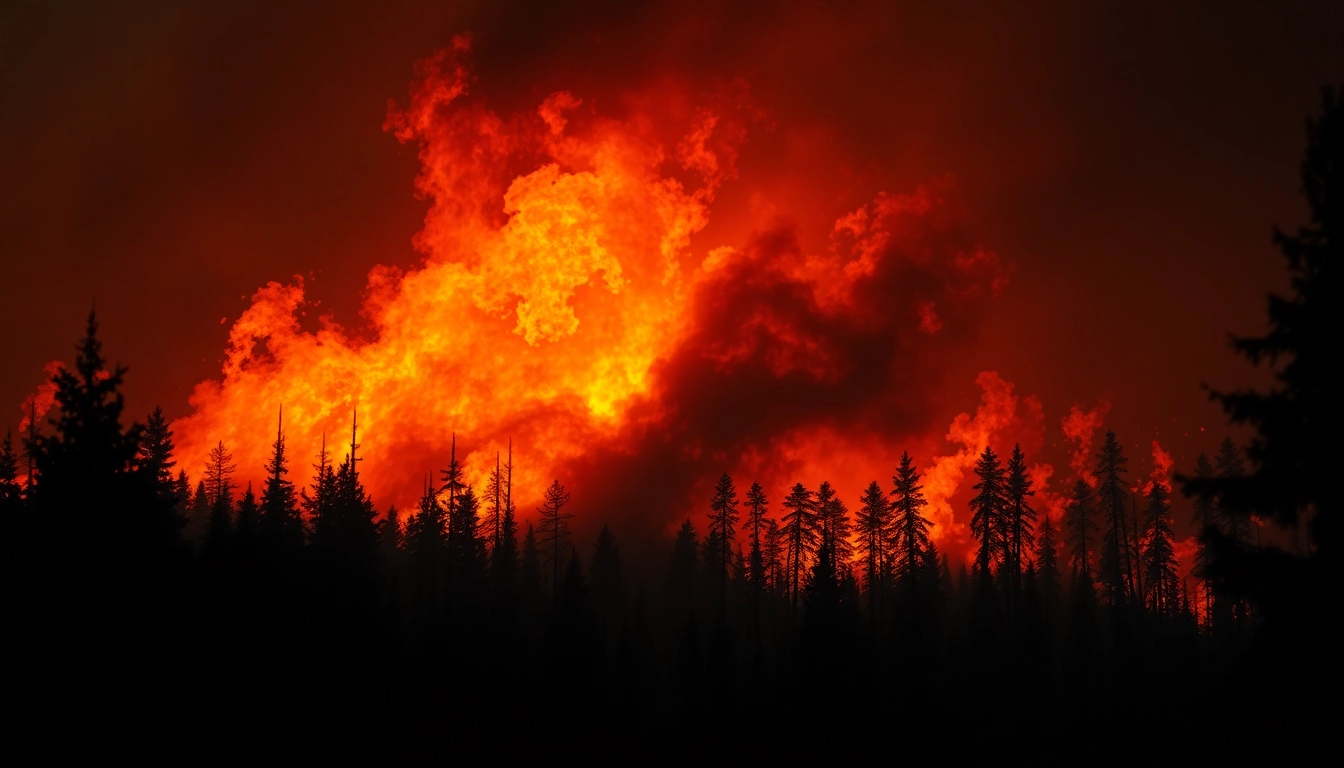Introduction to Wildfire Events
Wildfires are natural disasters that threaten ecosystems, human life, and property. Understanding the dynamics of these events is essential for effective management and prevention. With the increasing frequency and intensity of wildfires globally, particularly in regions prone to dry weather, it is critical to recognize the impact of climate change, human activities, and natural phenomena on wildfire events. This article aims to explore the complexities surrounding wildfire events, including their definitions, historical perspectives, causes, consequences, and mitigation strategies. For anyone interested in the topic of wildfire events, this comprehensive analysis provides insights into current trends, technological innovations, and global perspectives on wildfire management.
Defining Wildfire Events and Their Scope
Wildfire events encompass a range of uncontrolled fires that occur in natural environments, characterized by the rapid spread of flames fueled by dry vegetation, wind, and other climatic factors. These fires can occur in forests, grasslands, and other wilderness areas, often leading to significant ecological and economic consequences. Understanding the scope of wildfire events requires an examination of their classifications, which include:
- Surface Fires: These fires consume the forest floor and grasses, usually moving slowly and having a lower intensity.
- Crown Fires: More intense, crown fires burn through the tops of trees, rapidly spreading from tree to tree, particularly in dense forests.
- Ground Fires: Occurring below the surface, ground fires can smolder for extended periods and are typically difficult to detect and extinguish.
Each classification presents unique challenges for wildfire management and suppression efforts.
Historical Perspectives on Wildfires
Throughout history, wildfires have played a dual role in shaping ecosystems and human settlements. Indigenous peoples often used fire as a land management tool, promoting the growth of certain plant species and maintaining biodiversity. However, the perception of fire as a destructive force grew, particularly after major wildfires in the 20th century that devastated communities across the United States and Australia.
The infamous “Great Fire of 1910” in the U.S. burned approximately 3 million acres and led to the establishment of aggressive fire suppression policies. Understanding these historical events helps contextualize modern wildfire management practices, where the balance between natural fire cycles and suppression efforts remains a contentious issue.
Impact of Climate Change on Wildfire Frequency
Climate change significantly intensifies the frequency and severity of wildfire events. Rising global temperatures, changing precipitation patterns, and increased drought conditions create an ideal environment for wildfires. According to the National Interagency Fire Center, the wildfire season has grown longer and more unpredictable due to climate change trends.
For instance, in California, research indicates that wildfire seasons now last about 75 days longer than in the 1970s, leading to devastating fire events like the Camp Fire in 2018. Mitigating the impact of climate change on wildfire frequency requires a multifaceted approach, including sustainable land management practices and community preparedness.
Causes of Wildfire Events
Natural Causes: Lightning and Weather
Natural causes of wildfires primarily include lightning strikes and environmental conditions that promote fire ignition and spread. In fact, lightning is responsible for approximately 50% of all wildfires. The weather plays a crucial role as well; hot temperatures, low humidity, and strong winds can rapidly escalate a small spark into a large-scale inferno. For example, the 2020 Australian bushfires were exacerbated by prolonged drought and extreme heat, creating conditions ripe for extensive fire behavior.
Human Activities Leading to Wildfire Events
Human activities contribute significantly to wildfire occurrences, with some of the most common causes being:
- Campfires: Unattended or improperly extinguished campfires ignite surrounding foliage.
- Cigarette Butts: Discarded cigarette butts can smolder for hours and lead to fires, particularly in dry conditions.
- Arson: Deliberate acts of setting fires for various motives pose a significant risk to virgin landscapes.
- Equipment Use: Sparks from machinery or vehicles can ignite dry grass and brush, causing fires in rural areas.
Recognizing the role of human activities in wildfire incidents is essential for developing more effective prevention strategies.
Understanding Fire Behavior and Ecosystem Effects
The behavior of wildfires is influenced by a complex interplay of environmental factors including topography, fuel moisture content, and wind patterns. For instance, fires on steep slopes tend to spread more rapidly due to increased wind velocity and heat rising. Understanding these dynamics can inform better wildfire management practices.
Moreover, wildfires can alter ecosystems profoundly, with both positive and negative effects. While they can destroy habitats and release carbon into the atmosphere, fire also plays a critical role in nutrient cycling and promoting new growth in certain plant species. Ecosystem resilience following wildfires can often depend on the health of the surrounding landscape prior to the fire.
Consequences of Wildfire Events
Environmental Impact: Flora and Fauna
The environmental consequences of wildfire events are far-reaching. In addition to immediate damage to flora and fauna, there are long-term impacts on biodiversity and ecosystem function. Some species, such as certain pine trees, rely on fire for regeneration, while others face extinction due to habitat loss. Over time, the recovery of burnt landscapes also plays a crucial role in restoring the balance of local ecosystems, offering opportunities for reforestation and the introduction of fire-resistant species.
Economic Costs Associated with Wildfires
Wildfires impose substantial economic costs on communities, governments, and ecosystems. The costs associated with firefighting efforts alone can be astronomical, not to mention the devastation of property and infrastructure. The U.S. Forest Service reported expenditures exceeding $3 billion in wildfire response annually since 2015. Other economic impacts include loss of timber production, diminished tourism revenue, and increased healthcare costs from smoke-related illnesses. As such, proactive investment in wildfire prevention and preparedness can mitigate these extensive costs.
Health Risks from Smoke and Ash
The health risks associated with wildfires are increasingly recognized, given the prevalence of wildfire smoke during active fire events. Wildfire smoke is a complex mixture of gases and fine particulate matter that can lead to respiratory and cardiovascular issues among populations exposed to it. Vulnerable groups, such as children, the elderly, and individuals with chronic health conditions, are at particular risk. Monitoring air quality and providing timely public health responses are crucial to minimizing these health impacts.
Mitigation and Management Strategies
Community Preparedness Plans for Wildfire Events
Building resilience against wildfire events starts at the community level. Effective community preparedness plans involve collaboration among local agencies and organizations to establish protocols for disaster response, evacuation routes, and resource allocation. Various frameworks advocate for community engagement, where residents can participate in creating fire-prone landscape management strategies and develop emergency plans. Training and preparedness exercises can significantly enhance community resilience during actual wildfire events.
Role of Firebreaks and Controlled Burns
Firebreaks are strategically cleared areas designed to slow or stop the spread of wildfires, primarily through the removal of combustible vegetation. Similarly, controlled burns, or prescribed fires, involve intentionally igniting controlled fires to reduce fuel loads and minimize the risk of larger, uncontrolled wildfires. Both strategies are essential tools in the wildfire management toolkit, providing avenues for proactive risk reduction and restoration of fire-adapted ecosystems.
Education and Awareness Programs
Public education and awareness are critical components of wildfire prevention strategies. Programs that inform communities about the risks and management practices can drive action, such as adhering to local burn bans, creating defensible spaces around homes, and recognizing the signs of an impending wildfire. Community workshops, informational pamphlets, and outreach campaigns can help foster a culture of preparedness that actively engages citizens in wildfire resilience.
Future Trends and Innovations in Wildfire Management
The Role of Technology in Monitoring Wildfires
Advancements in technology are revolutionizing wildfire detection, monitoring, and management. Satellite imagery, drones, and geographic information systems (GIS) are being increasingly adopted to assess fire behavior, predict spread patterns, and prioritize resource allocations. Innovative tools like AI modeling predict risk factors based on historical data, while mobile applications can alert communities in real-time to changing fire conditions, paving the way for timely and informed decisions.
Policy Implications for Sustainable Land Management
Developing effective policies to address wildfire risks requires a collaborative approach that considers ecological, economic, and social dimensions. Integrating wildfire planning into regional land-use policies can help mitigate dangers by promoting sustainable practices in forestry, agriculture, and urban development. Policymakers are increasingly recognizing the importance of adaptive management strategies that account for the complexities and uncertainties of climate change on wildfire dynamics.
Global Perspectives on Wildfire Events
Globally, wildfires are a pressing issue as many countries face similar challenges exacerbated by climate change. Countries like Australia and Canada experience extensive wildfire seasons, while Mediterranean countries often contend with summer wildfires. Sharing knowledge and strategies on wildfire management across borders can enhance resilience to wildfire events worldwide. International cooperation on research, policy formulation, and technology transfer is essential in combating the growing threat of wildfires.



